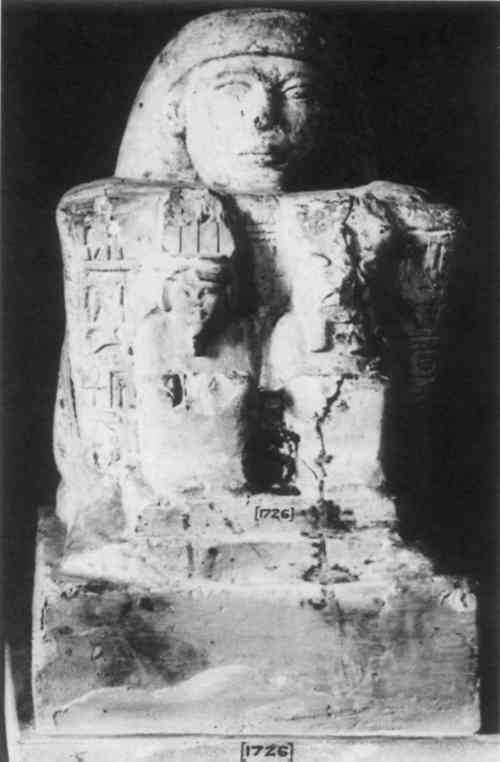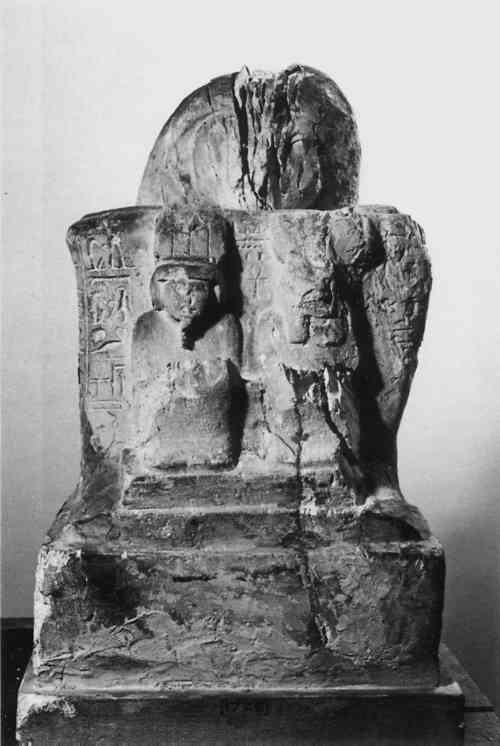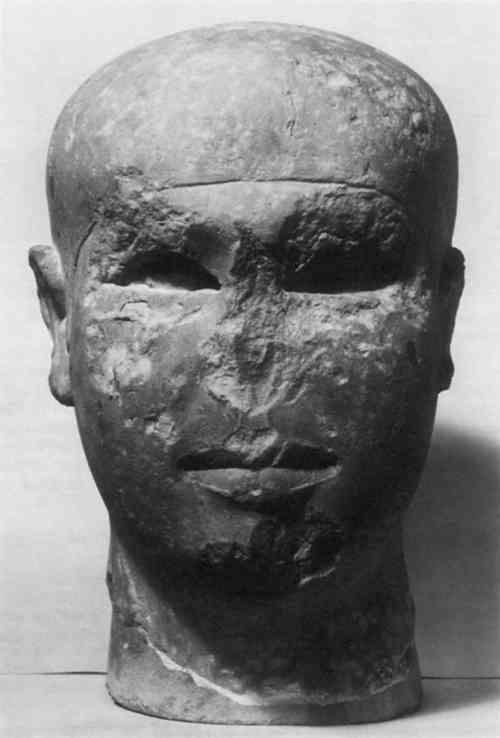A STUDY OF THE DETERIORATION OF EGYPTIAN LIMESTONE SCULPTURE
S.M. Bradley, & A.P. Middleton
1 INTRODUCTION
THE BRITISH MUSEUM has an important collection of Egyptian limestone sculptures. Since 1966 this collection has been the subject of a programme of conservation which has included cleaning, consolidation and repair 1–2. A comparison of the present condition of the sculptures with photographs taken when they were added to the collection in the late nineteenth and early twentieth century showed that a small number of sculptures had undergone considerable deterioration in the intervening period (Figures 1 and 2). These sculptures have been stored and displayed in a variety of locations in the museum but, because of a lack of detailed environmental records, it is not possible to relate the degree of deterioration to conditions of storage or display.
Fig. 1.
Block Statue of “Hati” with two squatting figures of Anuris and Mehyt (EA 1726), attributed to Abydos or Thinis; photographed about 1920.
 |
Fig. 2a.
Same sculpture as Figure 1, photographed in about 1940.
 |
Fig. 2b.
Same sculpture as Figure 1, photographed in about 1983.
 |
The adverse effect of changes in relative humidity (RH) and subsequent salt movement in contaminated stone have been well documented 3–7, and it is possible that the now badly deteriorated sculptures could have suffered most of this damage from exposure to unusually adverse conditions during or after their removal from the dry conditions of Egypt to the damp maritime climate of England. However it seemed unlikely that this was the only factor involved, since the majority of the sculptures in this collection are still in good condition. It was thought that the chemical and physical properties of the stone itself might render it more or less liable to decay. Factors other than salt content which have been identified as indicators of the durability of the stone include the nature and proportion of clay content 8–10, and pore size distribution, in particular the proportion of the micropores, less then 5 μm diameter 11–13.
To investigate the problem, a group of sculptures was selected for detailed examination and analysis; the sculptures included some which had suffered extensive deterioration in the Museum as well as some showing little or no evidence of decay. On examination of the Museum records it was found that the sculptures were attributed to three geographical areas: Thebes and Abydos; El Bersha; and sites around Giza and Saqqara, close to Cairo (Figure 3). The consistency of the analytical results within each geographical group (see below) suggests that the stated provenances of the objects are reliable. The pieces from Thebes/Abydos included those showing the most serious deterioration involving “structural decay,” in which the integrity of the stone is lost by splitting, fragmentation and flaking such as can be seen in Figure 1. This group of sculptures was identified as the “deteriorated” group. Many other sculptures from Thebes/Abydos show little evidence of decay and a number of these were selected to form a comparative group of “undeteriorated” sculptures from that area. All of the sculptures for El Bersha and from the Cairo area (Giza and Saqqara) show only minor deterioration, which is limited to “textural decay,” i.e. the surface of the sculpture shows localized pitting and powdering with some evidence of flaking but the underlying stone is sound, as illustrated in Figures 4 and 5. Details of all the sculptures examined are given in Table 1.
Fig. 3.
Map to show the attributed provenances of sculptures included in this study.
 |
Fig. 4.
Sculpted head (EA 114), attributed to Gizeh.
 |
Fig. 5.
Painted relief showing a procession of armed retainers (EA 1147), attributed to E1 Bersha.
 |
TABLE 1 Details of Sculptures
The investigation involved in the analysis of soluble salts, the determination of the amounts of acid insoluble matter, X-ray diffraction analysis (XRD) of the acid insoluble matter, petrographic examination of polished thin sections, and scanning electron microscopy on polished thin sections and fracture surfaces. In addition, porosity determinations were made on a number of samples using mercury porosimetry.
|





